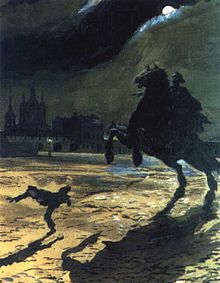
Back Bürünc atlı (poema) Azerbaijani Měděný jezdec Czech Der eherne Reiter (Gedicht) German Ο Χάλκινος Καβαλάρης (Πούσκιν) Greek El jinete de bronce Spanish سوارکار برنزی (شعر) Persian Le Cavalier de bronze (poème) French Պղնձե հեծյալ (պոեմ) Armenian Il cavaliere di bronzo (poema) Italian 青銅の騎士 (詩) Japanese
 Alexandre Benois's illustration to the poem (1904) | |
| Author | Alexander Pushkin |
|---|---|
| Original title | Медный Всадник [Mednyi Vsadnik] |
| Translator | C. E. Turner |
| Language | Russian |
| Genre | Narrative poem |
| Publisher | Sovremennik |
Publication date | 1837 |
| Publication place | Russia |
Published in English | 1882 |
The Bronze Horseman: A Petersburg Tale (Russian: Медный всадник: Петербургская повесть, romanized: Mednyy vsadnik: Peterburgskaya povest) is a narrative poem written by Alexander Pushkin in 1833 about the equestrian statue of Peter the Great in Saint Petersburg and the great flood of 1824. While the poem was written in 1833, it was not published in its entirety until after his death, as his work was under censorship due to the political nature of his other writings. Widely considered to be Pushkin's most successful narrative poem, The Bronze Horseman has had a lasting impact on Russian literature. The Pushkin critic A. D. P. Briggs praises the poem "as the best in the Russian language, and even the best poem written anywhere in the nineteenth century".[1] It is considered one of the most influential works in Russian literature and is one of the reasons Pushkin is often called the "founder of modern Russian literature".
The statue became known as The Bronze Horseman due to the great influence of the poem.[2]
- ^ Briggs, A. D. P. "Mednyy vsadnik [The Bronze Horseman]". The Literary Encyclopedia. 26 April 2005.accessed 30 November 2008.
- ^ For general comments on the poem's success and influence, see Binyon, T. J. (2002), Pushkin: A Biography. London: Harper Collins, p. 437; Rosenshield, Gary. (2003), Pushkin and the Genres of Madness. Madison, WI: University of Wisconsin Press, p. 91; Cornwell, Neil (ed.) (1998), Reference Guide to Russian Literature. London: Taylor and Francis, p. 677.